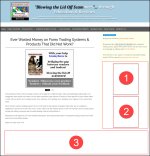A quick look at how to trade binary options
The steps on how to trade binary options can be summarized as follows;
Step 1 - Choose the asset to trade, whether it be a certain currency pair, stock, future or index.
Step 2 - Decide if price will close higher or lower than current price at the option expiration time which is usually an hour. If we believe the price of the asset will close ABOVE current price at expiry, we want to buy a CALL option. If we believe the price of the asset will close BELOW the current price at expiry, we want to buy a PUT option. Find out which way price action will likely move by looking at this chart example here.
Step 3 - Determine how much we will risk on the position. Could
be $50, $100, $500 or any other value depending on our confidence level
and risk tolerance.
If we are correct, we are said to be "in-the-money". This would
mean with binary options we would receive a predetermined payout of
about 70-80% of our original investment.
If the market moves in the opposite direction and we are wrong,
then we are "out-of-the-money". This would mean that we would lose all
of our investment for that position. (Or in some cases receive 10% of
original investment back).
If the asset price on our option closes at the exact same level, we are "at-the-money" and receive our original trading value back with neither profit nor loss.
More information about Binary Options
Binary Options, sometimes called digital or fixed return options, is a
simplified yet exciting method of trading the financial markets.
How can binary options trading be so profitable?
Binary options trading is high risk activity based on speculation
of market prices driven by near term economic events. Trading in binary
options involves high volatility movements and risk of loss. Traders
should pursue a responsible and disciplined approach to the market using
risk capital only –
meaning money that you can afford to lose.
What are the benefits of binary options trading?
Predetermined Risk & Return
Binary options keeps your risk known in advance by trading
options that offer pre-determined payouts whether they
close "in-the-money" or "out-of-the-money". Binaries offer a lower risk
profile than forex trading in that the payout on any option is
predetermined, with out-of-the-money trades paying out up to 10% of the
original trade. In no case can a trader lose more than his or her
original capital.
Profit from Rising & Falling Markets
Binary options are ideal for traders who want to profit from both
rising & falling markets. If you believe the price of an asset will
rise, buy a call option. If you believe the price of an asset will
fall, buy a put option. If your prediction is correct, earn up to 81%
profit on your trade.
No Commissions
No leverage or margin to calculate
Unlike forex trading, binary options offers a simpler, pre-determined P&L calculation on every trade.
Profit opportunities in multiple markets
Binary options are traded in multiple markets including forex and
shares, commodities like oil futures and market indices. Often times a
forex trader will need to endure long periods of relative inactivity and
short bursts of trading. Binary options trading is more versatile and
therefore offers more opportunities.
Positions automatically expire
Binary options automatically expire at the expiry time of the
trade, so there is no need to wait out optimal trades or constantly
re-calculate margin, risk and P&L considerations.
Example:
It's 1:15pm and EUR/USD currency pair is trading at 1.33680.
Positive economic news on US jobs is moving the US dollar up, and you
believe that the Euro will fall as investors move their money out of
safety and into higher profit US assets. Current payout on the trade is
81%. You believe EUR/USD price will fall below current levels and
execute a $100 trade or "Put Option" for
2:00pm expiry. The strike price on the trade is 1.33680. You were right
and EUR/USD price closed at 1.33480, below the strike price of 1.33680.
In this case the in-the-money payout is 81% of our trade so you win $81:
$100 x .81 = $81
If you were wrong and EUR/USD price closed above the strike price of
1.33680, say 1.33780, you would receive back the out-of-the-money payout
of 10%, in this case $10.
100 x .10 = $10
Binary options trading are based on limited risk, meaning in the above example $90 represents the maximum loss on that trade.
Terminology
1) Current price: the price of the underlying asset.
2) Strike price: the price of the underlying asset when the binary option is purchased.
3) Expiry price: The price of the underlying asset at the time of expiry of the binary option.
4) In-the money: a successful option trade i.e. A CALL option
that expired above the option price during purchase or a PUT option that
expired below the option price during purchase.
5) At-the-money: an option trade in which the price during
expiration is identical to the level at which the option was bought--in
such a scenario the initial investment amount is fully returned to the
customer.
6) Out-of-the-money: a failed option trade: A CALL option that
expired below the option price during purchase, or a PUT option that
expired above the option price during purchase.
Important
Binary Options are based on the European method of trading, meaning they
cannot close out prior to the option expiry time. The benefit to the trader is that the position
closes out automatically; so there is no need to monitor the trade or
re-calculate its P&L. Once closed the account balance is updated
right away.
For more information about options in general, go here.
A trading example of how to trade a binary option is here.





